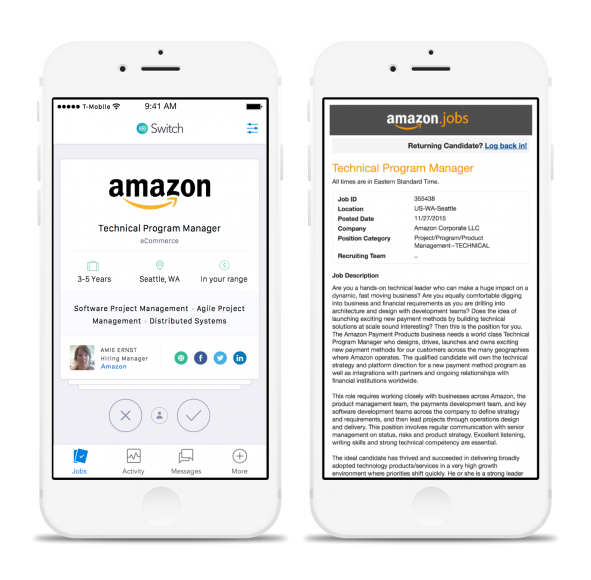The 4 Keys to a Winning Mobile Hiring Strategy

By now, you’ve probably seen the statistics. Depending on which study you consult, between 25 and 40 percent of all job seekers are incorporating mobile technology into their job hunt. Among those job seekers who own smartphones, the numbers are even more impressive. According to a 2014 Glassdoor report, 9 in 10 job seekers reported they would use mobile to search and apply for jobs in 2015. A recent Pew Research study returned similar findings: 94 percent of smartphone job seekers in that study said mobile was a big component of their job search.
Job seekers are taking to mobile to capitalize on the speed, efficiency, and convenience of the platform. For employers, the appeal should be similar, with the added bonus of mobile typically being a less expensive sourcing tool. Because it lends itself to greater autonomy for job seekers, mobile has also proven to be a way to tap into the hard-to-reach passive candidate pool.
What does all this mean for hiring managers? It means it’s time to start implementing a mobile hiring strategy; or, if you already have one, it’s time to ensure that it is comprehensive and dynamic enough to create a winning user experience.
Here are the four keys to successfully sourcing on smartphones:
1. Get There First
Mobile tech is all about speed, and mobile hiring is no different. This need for speed is more of a mindset than a concrete tool in your recruiting arsenal, but it is an important tenet to adopt.
In a general sense, speed can put you ahead of your competitors in mobile, since around 80 percent of Fortune 500 companies are not fully “mobilized.” That means that an investment in this space should yield immediate rewards.
After you’ve got your mobile hiring plan in place, the pace only quickens. Posting jobs to mobile as soon as they’re approved, screening candidates early and often, and pulling them into your funnel as soon as you think they’ll make a good fit are all vital to competing in this space.
2. Go Native

You may want to eventually rig your ATS for mobile, but the efficiency and cost-effectiveness of native apps makes them a highly practical and effective way to take your first steps into mobile hiring.
Be careful: a Web-responsive system, which scales down your desktop Web presence to fit on mobile, is not the full optimization that job seekers crave. Squeezing a traditional job posting to fit an iPhone or Android interface suggests a clunky, outdated hiring philosophy – and that will turn off high-quality candidates.
This warning is supported by the Pew Research Study referenced above, in which the greatest number of complaints from smartphone job seekers revolved around the lack of mobile-optimized displays.
3. Simplify and Streamline the Job Posting
While native hiring apps can help you avoid the ungainly display problems that come with Web-responsive systems, there are also some relatively simple streamlining techniques you can trigger on your end.
Consolidate your job postings to focus on only the most important details – e.g., the description, requirements, location, and nature of the work. Because mobile is at least in part about netting passive candidates, the more particulars you can provide – things like vacation policy, salary range, medical benefits – the more likely you are to have a high response rate. An intentionally vague, full-page posting might work on job boards or LinkedIn, but mobile demands a succinct, detail-heavy alternative in order to both catch and capture the attention of the mobile job seeker.
When you do receive interest from job seekers, don’t expect it to be in the traditional resume and cover letter format. More likely it will come in the form of a profile, a pared down version of a resume. Once you move the candidates you like into your funnel, you can choose whether to request a full resume or move onto the interview stage.

A mobile “job card” versus a responsive Web job posting scaled down to mobile.
4. Retrofit Your Funnel
The relative immediacy of mobile cannot succeed without hiring managers being open to a new approach. Whereas many top-of-funnel platforms work over time, a series of days or weeks, mobile tends to happen at a much faster pace. When job seekers can apply with one or two clicks or a swipe, they don’t expect to wait weeks for an employer reply. After all, frustration over endless wait times is why many started searching on mobile in the first place.
To truly adopt and succeed on mobile, you need to be as quick as the job seeker. Luckily, mobile sourcing is accessible from anywhere and, due to the shorter profiles and tap-to-like nature of mobile, candidates are easier to screen, too.
–
The numbers show that job searching on mobile is only growing in popularity. Those companies who meet it head on, early, and with a comprehensive strategy and implementation will win this particular war for talent.

